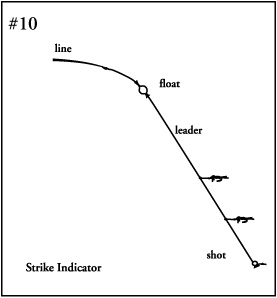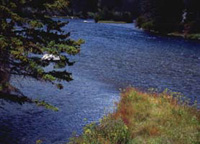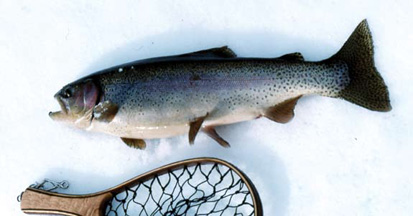Strike Indicator - Nymph Fishing
Nymphs are effectively fished in a natural dead drift motion just above the stream’s bottom structure. Here the current velocity is much slower than at its surface. Most nymphs are very poor swimmers and drift helplessly with the flow.
The angler’s goal is to choose the optimal amount of weight to both place the nymph just above the stream’s bottom and to match the current’s velocity. My favorite terminal tackle consists of a long, somewhat thin leader, a strike indicator, two nymphs (tied on short droppers), and removable split shot.
The strike indicators can be a corkie (attached with a broken toothpick), yarn (dressed with fly floatant), closed cell foam (attached with a ring), or one of the many other commercial strike indicators. No matter which indicator you choose, it should be easily moved and firmly attached to the leader.
Removable shot is used so that the amount of weight can be quickly adjusted to the stream’s depth and flow. The optimal amount of shot matches the current’s actual flow rate at the depth that the nymph is being fished. This speed is always slower than the speed at the surface. (See Figure 10)


A general rule is to adjust the weight so that the indicator is flowing more slowly than the surface bubbles and flotsam; usually one half of the surface speed matches the bottom speed. The shot is in direct contact with the bottom and is bouncing along in a tapping motion. When the strike-indicator hesitates or moves laterally or goes under, pull the rod in a downstream sweep. If a fish is felt, strike firmly to set the hook. With practice you can feel the difference between a snag and a fish. The key is to instantly set the hook when the strike indicator gives notice.
Nymph fishing is my method of choice at times of no insect hatches or emergences. Fish are foraging during these lean times and are usually not as selective as when a hatch is occurring. A well presented nymph usually results in an immediate strike. The underwater feeding lanes may vary in accordance with temperature, flow rate, and water clarity. Try to completely cover all of the possible holding lies where a fish may be found.
At times of insect emergence the fish can become selective and the emerging insects must be closely matched. At times of non-emergence, a variety of nymphs native to the stream can be effective.
Other terminal tackle set ups are also effective. Instead of shot, a weighted fly can be used. Here the fly acts as the weight and sinks into the desired depth.

The problem with the weighted fly is that it’s difficult to adjust its weight to effectively fish various lies with different flows.
Bead-head nymphs are heavier than non-bead-head flies. Wraps of lead or copper wire can be tied underneath the fly.
Adding shot above the fly can cause it to ride too close to the stream’s bottom, making it more snag prone and less visible to the fish.

© 2026 The Gale Group, Inc. All rights reserved.
© 2026 Perigee Learning LLC. All rights reserved.
LoveTheOutdoors.com is owned and operated by Advameg, Inc. © 2026 Advameg, Inc.
Camping Adventures • Dutch Oven Cooking • Sports Knots
Fly Tying • Freshwater Fishing • Fly Fishing

